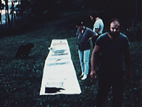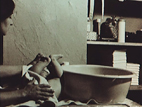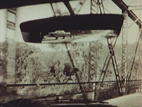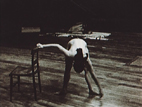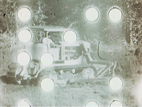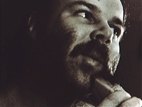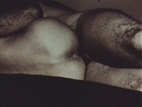Excerpts from ROLLS: 1971
- Robert Huot |
- 1971-72 |
- 48 minutes |
- COLOR/B&W |
- SOUND
Rental Format(s): DVD-R
Sale Format(s): DVD
An excerpt from THE FILMS OF ROBERT HUOT: 1967 to 1972 by Scott MacDonald
Rolls: 1971 is so powerful and so unusual in its emotional effects that I find it difficult to discuss. To create this Huot used twenty-two rolls of film shot during 1971, along with bits of other found footage and from materials photographed during the same period. Some of this material is similar to the very best minimal rolls from One Year (1970); other portions are more like the informal later rolls of the earlier film. In addition, he included a good deal of unusually personal imagery (some of it quite sexually explicit), mostly involving himself, Twyla Tharp (she and Huot were married at the time), and their son Jesse. These various kinds of imagery are integrated within a complex and highly suggestive editing strategy which involves the presentation of imagery in two very different ways. In thirteen instances Huot includes complete, unedited rolls "flares and all" just as he did consistently in One Year (1970). Each of these thirteen rolls, however, is preceded and followed by a passage composed of exactly 252 one-second shots taken from both the thirteen rolls including complete and from the other nine rolls and the additional footage. These passages of one-second shots - there are fourteen in all - are organized according to a complex pattern which allows for considerable variety in the kinds of juxtapositions which occur between one-second units. The specifics of the pattern are as follows (the individual numbers refer to the twenty-two original rolls of material used regularly during the film, numbered according to their first appearances; "m" refers to miscellaneous material culled from other sources):
1 2 3
1 4 5 3 4 2 5
1 6 7 2 6 3 7 4 6 5 7
1 8 9 2 8 3 9 4 8 5 9 6 8 7 9
1 10 11 2 10 3 11 4 10 5 11 6 10 7 11 8 10 9 11
1 12 13 2 12 3 13 4 12 5 13 6 12 7 13 8 12 9 13 10 12 11 13
1 14 15 2 14 3 15 4 14 5 15 6 14 7 15 8 14 9 15 10 14 11 15 12 13 14 13 15
1 16 17 2 16 3 17 4 16 5 17 6 16 7 17 8 16 9 17 10 16 11 17 12 16 13 17 14 16 15 17
1 18 19 2 18 3 19 4 18 5 19 6 18 7 19 8 18 9 19 10 18 11 19 12 18 13 19 14 18 15 19 16 18 17 19
1 20 21 2 20 3 21 4 20 5 21 6 20 7 21 8 20 9 21 10 20 11 21 12 20 13 21 14 20 16 21 16 20 17 21
18 20 19 21
1 22 m 2 22 3 m 4 22 5 m 6 22 7 m 8 22 9 m 10 22 11 m 12 22 13 m 14 22 15 m 16 22 17 m 18 22 19
m 20 22 21 m
This pattern remains the same throughout the film, though the specifics of the juxtapositions vary a good deal because the individual one-second units used during successive repetitions are always taken from positions progressively further into the original rolls. Huot's complex editing strategy seems calculated actively to involve the viewer in the film to an unusual degree. The passages of one-second shots have a good deal in common with Eisensteinian montage. In many instances, in fact, the formal and thematic differences between consecutive one-second units are at least as diverse as anything in the Odessa Steps sequence.
The first six images of the film, for example, are:
1. A beautiful composed long shot of a heavy snowfall
2. A close-up of Tharp breastfeeding Jesse Huot
3. A medium shot of Tharp spoon feeding Jesse Huot, apparently some months older than in the previous shot.
4. Another long shot of the heavy snowfall
5. An extreme long shot of a windy summer landscape
6. A close-up of Huot beginning to masturbate
The radical disparities between units which are evident here occur regularly throughout each of the one-second passages; in fact, near the ends of these passages, where a single second often contains several bits of very different information, the bombardment is even more intense. The relentless pace of the one-second passages offers a rather bewildering amount of information to viewers (this seems especially the case during a first viewing, before the pattern's repetitive nature has been established), and the constantly changing collisions of imagery can engage the viewer in a wide range of formal and thematic considerations. The juxtapositions of one-second units, for example, often seem to imply relationships, some of which are complex and multi-leveled (in one instance a shot of a bulldozer plowing a field occurs next to one made by Huot's scratching directly into dark leader); others rather startling in their potential implications (in at least one instance, the artificial insemination of a cow occurs next to a shot of Tharp nursing Jesse Huot). Sometimes the eye spots a particular aspect of consecutive shots which for a few seconds at least, becomes a motif. I am often aware of an interplay between the various grains of the film stocks and such aspects of the imagery as snowflakes and drops of semen. A more general kind of involvement often occurs once viewers are aware that the one-second units are arranged in a particular pattern and grow interested in determining its specifics. The complexity of the pattern can sustain such curiosity for a considerable time.
While the thirteen unedited rolls, many of which are shot continuously from a single camera position, generally provide "breathers" from the highly edited passages, some of them demand other forms of involvement. The roll of the heavy snowfall (the first complete roll presented in the film) engages the viewer's eyes in a constant process of adjustment and readjustment between foreground and background; the roll of Tharp nursing Jesse Huot (the second complete roll) is composed so that while viewers know at once what is being presented, a full minute can go by before the entirety of the composition can be seen and understood. Perhaps the most disconcerting complete roll (the fifth) is an explicit close-up of Huot masturbating, which is composed in such a way that even viewers who are bothered by the subject matter and would normally look away tend to become engaged in deciphering the details of what they see; to make the roll, Huot stood straddling the mirror and photographed vertically down his body; the image is framed so that the mystery of the set-up is not solved for some viewers until Huot ejaculates and the semen strikes the surface of the mirror. Other, less formal rolls create other types of involvement: one is amused to discover the accidental rituals surrounding Huot's and Tharp's unrolling of a long, long painting (actually the first of Huot's diary paintings); one follows the unpredictable movements of a group of playful kittens in and out of the image; and so forth.
Still other forms of viewer-involvement are created by the basic alteration of complete rolls and edited passages. For one thing, once the general organization of the film is clear to the viewers, a certain amount of suspense is created by their curiosity about which complete roll will be screened next. This general curiosity is intensified, in some instances, by the desire to have a more complete look at imagery which tends to be mysterious in its one-second appearances and, in other instances, by the fear of a sustained confrontation of personal sexual imagery which remains relatively easy to handle in one-second passages. Secondly, each addition of a new complete roll changes the viewer's perception of subsequent one-second passages; one grows increasingly familiar with some portions of the passages, more curious about other portions. A third general result is a lesson in the importance of context. I am frequently amazed by the degree to which the identical imagery looks different, depending on whether one sees it explored and understood as in the roll of Tharp nursing Jesse Huot, for instance, I sometimes have trouble deciphering the image in its one-second occurrences. Huot's heavy involvement of the viewer in Rolls: 1971 is a function of his obvious commitment to communicating the vision which is embodied in the content and organization of the film. The combination of Huot's amalgamation of two radically different approaches into an almost combative form and his use of this form to present imagery so open and revealing that the decision to use it required a personal vulnerability equal to the film's formal power results in an extremely untraditional autobiographical work in which unusual sorts or "perspective" are consistently undermined. While Huot's lack of traditional restraint runs the risk of seeming immodestly self-indulgent to some viewers, it adds a crucial element to the finished film: by developing such an intimate contact between filmmaker and viewer, the most serious sorts of reflection about what a film should be and how it should relate to the viewer's personal life can hardly be avoided. Rolls: 1971 does more than serve as a general catalyst for viewers' reconsiderations of their habitual assumptions, however. Specifics of the film suggest fruitful modifications of what many viewers tend to accept as normal. Huot's decision to use only two kinds of durations - one second, complete roll - creates a leveling effect in which "normal" hierarchical judgments tend to be suspended. Plowing a field, looking at a painting, having sex, looking at a landscape, driving a car, etc. are all seen as integral, important parts of life in which the health of the individuals is determined by their ability to function effectively in the ecological system and to relate fruitfully with one another. Consumerism and the institutional and sociological patterns which thrive on it, particularly those that tend to weaken the dignity of individuals or detach people from fundamental physical needs and desires, are implicitly rejected by being excluded. Specific alternatives are implicit throughout the film. Huot's presentation of family life and of sexuality are particularly good examples.
While much of Rolls: 1971 is involved in the process of raising a child, one never sees a "family unit" in the usual sense of that term; there is no "head of household," no housewife. Instead, one sees three individuals. At times they obviously work together, but they also pursue their own interests, and no filmic distinction is made between these; no mystification of family togetherness is developed at the expense of anyone's individuality. One of the most moving rolls in this regard is the one in which Tharp (a significant figure in contemporary dance) does exercises, apparently getting back into shape after the layoff necessitated by having a baby. For a long time, she seems quite alone - except for Huot, who is respectfully filming her - and then for a second the camera and she move so that one sees the baby playing quite contentedly in the background. In Rolls: 1971 a healthy family is not a group of people, all serving a male, so that the group can be secure and comfortable economically; it is a group of individuals who, for a time, share their interests so that all can grow. Sexuality in Rolls: 1971 is not limited to a "correct place." Because of the specifics of Huot's overall organization of the film, the viewer is likely to come across sexual imagery at any moment, and, as a result, grows accustomed to the idea that sexuality - both sexuality between partners and with one's own body - is simply a natural ongoing part of life, neither more nor less important than the other activities recorded in the film. While Huot's presentation of sex is quite explicit, it is also clear and matter-of-fact. Sex is presented as a demystified physical activity; there is no attempt to romanticize the hairy particularity of normal adult bodies.
A final important dimension of Huot's vision in Rolls: 1971 is suggested by elements in the structure of the film which keep it from being entirely predictable. One is the miscellaneous material which is the last addition to the one-second pattern. Even on the first viewing, the viewer quickly realizes that though the overall pattern of one-second shots maybe perfectly regular, the pattern seems to disintegrate at the end as a result of the addition of a considerable range of new material in an undefined order: shots of a film on TV photographed in a mirror; a cow being artificially inseminated; scratches on dark leader, footage of tractors overlaid with color painted directly onto the colloid; color footage of a stripper, etc. Since even the most careful examination of this material reveals no clear organization, one is not surprised to learn that it was selected at random from out-takes which had been thrown into a box during the construction of other films. The structure of the overall film has a similar loose end. During my first viewing of Rolls: 1971 I assumed that it would end as soon as I had seen all the imagery, both in complete-roll form and broken down into one-second units; and I was shocked when the intermittent one-second intervals of darkness which signal the end began to appear in the one-second passage after the thirteenth complete-roll. Huot's decision to setup repetitive patterns which he ultimately refuses to carry to the conclusion one comes to expect that has interesting thematic implications. The one element which unites nearly all the multifarious imagery presented in Rolls: 1971 is its participation in an ongoing process of growth and creativity: a baby is learning to eat, stand, to know his parents; a man and woman are exploring themselves and each other sexually and aesthetically; the change of seasons is bringing a new cycle of planting and harvest; and the viewer is developing his awareness and sensitivity to all of these processes. By ending the film with nearly all activities still in progress, Huot keeps his structure from implicitly encaging his call for creative evolution; instead of implying a rigid final plan, Rolls: 1971 invites viewers to become involved in the ever ongoing process of making human life more genuine and more fulfilling.
The full text can be seen at http://www.roberthuot.com/surprise/





